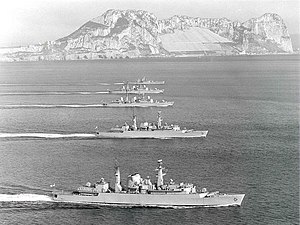1981 Alquiyan-Seketese crisis: Difference between revisions
(→Armed escalation: finish?) |
(people) |
||
| Line 26: | Line 26: | ||
| combatant2 = {{flagicon image|Flag of Seketan.svg}} [[Seketan]] | | combatant2 = {{flagicon image|Flag of Seketan.svg}} [[Seketan]] | ||
| combatant3 = {{flagicon image|Flag of Europe.svg}} {{wp|Council of Europe}}<br>{{flagicon image|Flag of the United Nations.svg}} {{wp|United Nations Department of Peace Operations|UN DPKO}}<br>{{wp|Conference on Security and Co-operation in Europe|CSCE}} | | combatant3 = {{flagicon image|Flag of Europe.svg}} {{wp|Council of Europe}}<br>{{flagicon image|Flag of the United Nations.svg}} {{wp|United Nations Department of Peace Operations|UN DPKO}}<br>{{wp|Conference on Security and Co-operation in Europe|CSCE}} | ||
| commander1 = | | commander1 = {{flagicon image|Flag of Alquiya.svg}} [[Damynen Sazzes]] | ||
| commander2 = {{flagicon image|Flag of Seketan.svg}} [[Patjik Moulette]] | | commander2 = {{flagicon image|Flag of Seketan.svg}} [[Patjik Moulette]] | ||
| commander3 = | | commander3 = {{flagicon image|Flag of Europe.svg}} {{wp|Franz Karasek}} | ||
| units1 = | | units1 = | ||
| units2 = | | units2 = | ||
Latest revision as of 03:02, 28 October 2023
| 1981 Alquiyan-Seketese crisis | ||||||||
|---|---|---|---|---|---|---|---|---|
| Part of the Nelborne conflict | ||||||||
 Alquiyan ships in the Treb Bay | ||||||||
| ||||||||
| Belligerents | ||||||||
|
|
|
CSCE | ||||||
| Commanders and leaders | ||||||||
|
|
|
| ||||||
The 1981 Alquiyan-Seketese crisis was an international crisis in the Nelborne between Alquiya and Seketan in the aftermath of the Nelborne Spring over the status of their disputed border near the Rynedan peninsula and, to a lesser extent, the broader Trjebian dispute.
Background
Alquiya
Seketan
Rynedan peninsula & Trjebia
Beginnings of the crisis
The start of the crisis began during a routine Ministers Address to the Alquiyan National Assembly on 9 September 1981. At the lectern was the newly appointed Alquiyan Minister of Defense Simion Xrsaza, reading to the assembly his agenda for the coming term. Opposition parties opposed his appointment to the role as Xrsaza previously did not have foreign affairs experience, having been a wealthy businessman and local Mayor of Keldaj before his appointment. His selection as Minister was characterized as purely electoral, to secure support in Alquiya's third-largest city. Nearing the end of his speech, Xrsaza remarked;
...It is this government's goal to defend the constitutional lands of our republic that many fought for, anywhere, and anyway how. It is my personal responsibility to see this goal through.
This remark was a cause for concern in the FKT and Seketese governments. While the border between Alquiya and its neighbours had been de facto settled by the Treaty of Glasgow after the Nelborne War, Alquiya continued to de jure recognize the Seketese region of the Rynedan peninsula and the FKT as part of their union through their constitution. Both governments secretly assembled crisis committees to prepare in case of an Alquiyan invasion. It was even leaked in 2009 that Seketan had seriously considered a pre-emptive strike against Alquiya.
On 13 September 1981, Seketese Foreign Affairs Minister James Šaþenji condemned the comments to a press conference, stating his government's position to "... defend the agreed to terms of the Treaty of Reykjavik...". Šaþenji was rushed out of the room almost immediately afterwards, leaving his inexperienced 31-year-old press secretary Josefe Hykyn to take questions from the press, leading to a disastrous media scrum. A reporter from the BBC asked how far Seketan would go to protect the treaty, with Hykyn's responding "[the Minister] is ready to use whatever he sees fit [to defend]]". Another reporter from SekNews asked if a first strike was ever considered, to which Hynyk replied "I don't know, though the government will not write anything off".
This chaotic press conference sent shockwaves through the Nelborne, given how open-ended Hykyn had been with his answers. Since his 12 September address to the Assembly, Xrsaza had done very little with regard to his speech, seemingly as if he did not know the ramifications of his phrasing. In his retirement, Xrsaza would later say that was "... totally unaware that the [Rynedan] peninsula was in the constitution". Regardless, prominent figures in the Alquiyan government and military saw this as Seketan preparing to strike first. With both sides seeing each other as a possible aggressor, the crisis began with each side ramping up military readiness.
Armed escalation
On 15 September, the Alquiyan Defense Council ordered its navy to create a task force, made up of 1 Sjanor class frigate, 6 Basen class destroyers and 3 Amvel class subamrines. Declassified documents in 2013 revealed that the initial intention for this task force was to be a preemptive strike force against Seketese military facilities around the Treb Bay and on the Rynedan peninsula. Draft armament requests included sea-to-land missiles and memos showed military planners requesting the inclusion of a amphibious assault vessel in the task force. By 16 September, these plans were mostly abandoned, with the task force being used as a show of force towards Seketan. In conjunction with the naval task force, 3 divisions of the Alquiyan Land Forces, 1st armoured 6th mountain, 7th infantry, totalling 28,000 men were set too high alert status, to be ready to move out with 24 hours notice. In the meanwhile, Seketan had done virtually nothing regarding the tensions. Their nearest fleet, stationed at Base Allis in Prynsten, was undergoing seasonal repairs, with a few ships having their engines or guns off the board in repair shops on land. The Seketese Army was also unprepared for any confrontation. In the aftermath of the recent revolution, the government of Seketan mandated a doctrinal change that deemphasize constant military readiness and a reduction of military personnel. Only a single brigade, the 5th, totalling 3600 troops was stationed at Base Allis.
